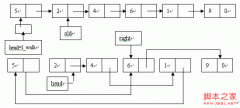C语言中qsort函数用法实例小结
这篇文章主要介绍了C语言中qsort函数用法,包括了针对各种数据类型参数的排序,非常具有实用价值,需要的朋友可以参考下
本文实例汇总了C语言中qsort函数的常见用法,非常具有实用价值。分享给大家供大家参考。具体分析如下:
C语言中的qsort函数包含在<stdlib.h>的头文件里,本文中排序都是采用的从小到大排序。
一、对int类型数组排序
int num[100];
int cmp ( const void *a , const void *b )
{
return *(int *)a - *(int *)b;
}
qsort(num,100,sizeof(num[0]),cmp);
二、对char类型数组排序(同int类型)
char word[100];
int cmp( const void *a , const void *b )
{
return *(char *)a - *(char *)b;
}
qsort(word,100,sizeof(word[0]),cmp);
三、对double类型数组排序(特别要注意)
double in[100];
int cmp( const void *a , const void *b )
{
return *(double *)a > *(double *)b ? 1 : -1;
}
qsort(in,100,sizeof(in[0]),cmp);
四、对结构体一级排序
struct In
{
double data;
int other;
}s[100];
int cmp( const void *a ,const void *b)
{
return (*(struct In *)a)->data > (*(struct In *)b)->data ? 1 : -1;
}
qsort(s,100,sizeof(s[0]),cmp);
五、对结构体二级排序
struct In
{
int x;
int y;
}s[100];
//按照x从小到大排序,当x相等时按照y从大到小排序
int cmp( const void *a , const void *b )
{
struct In *c = (struct In *)a;
struct In *d = (struct In *)b;
if(c->x != d->x) return c->x - d->x;
else return d->y - c->y;
}
qsort(s,100,sizeof(s[0]),cmp);
六、对字符串进行排序
struct In
{
int data;
char str[100];
}s[100];
//按照结构体中字符串str的字典顺序排序
int cmp ( const void *a , const void *b )
{
return strcmp( (*(struct In *)a)->str , (*(struct In *)b)->str );
}
qsort(s,100,sizeof(s[0]),cmp);
相信本文所述实例对大家C程序设计的学习有一定的借鉴价值。
- 上一篇:C语言指针的长度和类型深入分析
- 下一篇:C语言泛型编程实例教程
精彩图集
精彩文章





